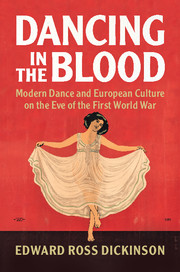Book contents
- Dancing in the Blood
- Dancing in the Blood
- Copyright page
- Contents
- Illustrations
- Acknowledgments
- Abbreviations
- Introduction: Modern Dance and the Birth of the Twentieth Century
- Chapter 1 Modern Dance and the Business of Popular Culture
- Chapter 2 Art, Women, Liberation
- Chapter 3 Blood and Make-Believe: Race, Identity, and Performance
- Chapter 4 Embodied Revelation: Dance, Religion, and Knowledge
- Chapter 5 Legacies: Dance as Profession, Spectacle, Therapy, and Politics
- Conclusion: Coherent Contradictions in Modernism and Modernity
- Bibliography
- Index
- References
Bibliography
Published online by Cambridge University Press: 22 July 2017
- Dancing in the Blood
- Dancing in the Blood
- Copyright page
- Contents
- Illustrations
- Acknowledgments
- Abbreviations
- Introduction: Modern Dance and the Birth of the Twentieth Century
- Chapter 1 Modern Dance and the Business of Popular Culture
- Chapter 2 Art, Women, Liberation
- Chapter 3 Blood and Make-Believe: Race, Identity, and Performance
- Chapter 4 Embodied Revelation: Dance, Religion, and Knowledge
- Chapter 5 Legacies: Dance as Profession, Spectacle, Therapy, and Politics
- Conclusion: Coherent Contradictions in Modernism and Modernity
- Bibliography
- Index
- References
- Type
- Chapter
- Information
- Dancing in the BloodModern Dance and European Culture on the Eve of the First World War, pp. 267 - 292Publisher: Cambridge University PressPrint publication year: 2017



